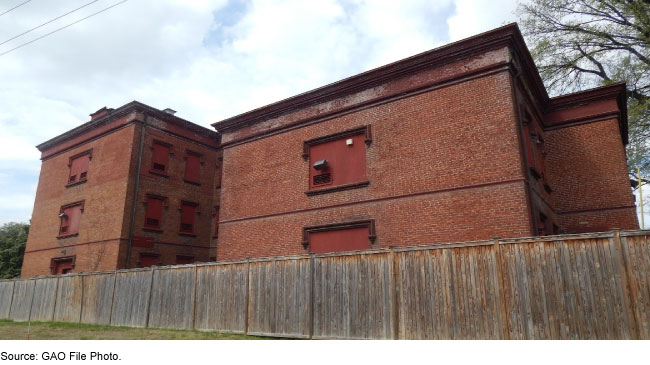Federal Real Property: More Consistent Monitoring of Asbestos Could Improve Oversight
Fast Facts
The General Services Administration is responsible for the cost of cleaning up environmental contaminants—such as asbestos—on federal property. Contaminants can also make it harder or more costly for GSA to sell buildings that the government no longer needs.
GSA requires asbestos inspections every 5 years for each federal building built before 1998. But about 2/3 of GSA's buildings haven't been inspected in the last 5 years—including some with no known inspection dates and others that haven't been inspected in more than a decade.
We recommended GSA ensure asbestos inspections are completed per policy or revise policies to address the backlog.
A vacant GSA-owned building in Washington D.C. with hundreds of thousands of dollars in estimated asbestos cleanup costs.

Highlights
What GAO Found
The General Services Administration (GSA) may be legally responsible for the cleanup of environmental contaminants on federal properties it manages before it disposes of those properties via sale or other means. GSA annually reports its environmental liabilities across three categories: asbestos, non-asbestos (e.g., lead paint), and hazardous releases (e.g., petroleum). GSA uses a formula to estimate the costs to address asbestos and non-asbestos contamination, which together account for 95 percent of its annually reported liabilities. GSA bases its liability estimates for hazardous releases on site-specific information gathered by GSA's regional environmental managers. GSA's estimated environmental liabilities were largely stable between fiscal years 2018 and 2022, ranging from $1.8 to $2.0 billion.
GSA manages asbestos and non-asbestos contamination in place—as these materials pose little health risk when not damaged or disturbed—and GSA officials said they take immediate action on hazardous releases. To manage asbestos in place, GSA policy requires buildings that could contain asbestos materials be inspected every 5 years. However, according to GSA data, approximately two-thirds of buildings (638 of 955) were out of compliance with this inspection policy. Buildings out of compliance include hundreds in which GSA has not conducted an inspection in more than a decade or does not know when the most recent inspection occurred.
Buildings Out of Compliance with General Services Administration's 5-Year Asbestos Inspection Policy, as of September 2023

GSA officials provided several reasons these buildings are out of compliance with GSA's asbestos inspection policy, including funding and staffing challenges, incomplete records, and limitations with the database used to track asbestos inspections. GSA officials said they are developing a comprehensive plan for completing required inspections and considering changes to the asbestos policy to follow a more risk-based approach. These officials said they have not yet identified specifics of this plan, including timelines for completing required inspections or for modifying the policy. As a result, GSA does not have key data needed to monitor asbestos and protect health and safety.
Why GAO Did This Study
GSA's cleanup of environmental liabilities on federal properties represents a fiscal exposure for the federal government. The federal government's growing environmental liabilities and federal real property management are on GAO's High-Risk list, partly due to these challenges.
GAO was asked to review how GSA estimates and manages its environmental liabilities. This report examines, among other objectives: (1) how GSA estimates environmental liabilities and (2) how GSA manages environmental contaminants and the extent to which GSA follows its asbestos management policy.
GAO reviewed GSA's asbestos management policy, annual financial reports, cost estimation formulas, budget and expenditure information, real property data, and conducted three site visits. GAO also interviewed GSA officials, contractors, and subject matter experts.
Recommendations
GAO is recommending that GSA implement a plan to ensure asbestos inspections are conducted in accordance with its policy or revise its policy to incorporate a risk-based approach. GSA agreed with the recommendation and stated that it is developing a plan to address it.
Recommendations for Executive Action
| Agency Affected | Recommendation | Status |
|---|---|---|
| General Services Administration | The Administrator of GSA should either implement a plan to ensure that asbestos inspections are conducted in accordance with GSA's current asbestos management policy or revise the policy to incorporate a risk-based approach. Such a plan could include strategies to address funding gaps, a timeline for completing missing inspections or updating the asbestos management policy, and steps to update the IRIS database to allow GSA to better monitor compliance with the policy. (Recommendation 1) |
As of April 2024, GSA was reviewing and revising its asbestos management policy to incorporate a risk-based approach. GSA plans to issue and communicate this updated policy to GSA employees and tenant agencies. GSA also plans to develop action plans to complete any missing asbestos building inspections and implement enhancements to its information technology systems. GAO will continue to monitor GSA's progress.
|
